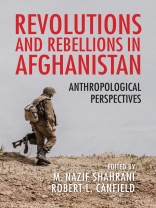When originally published in 1984, Revolutions and Rebellions in Afghanistan provided the first focused consideration of the 1978 Saur Revolution and the subsequent Soviet invasion and occupation of the country. Nearly four decades later, its conclusions remain crucial to understanding Afghanistan today.
In this much-anticipated re-release, Revolutions and Rebellions in Afghanistan offers an opportunity for fresh insight into the antecedents of the nation’s enduring conflicts. A new foreword by editors M. Nazif Shahrani and Robert L. Canfield contextualizes this collection, which relies on extensive fieldwork in the years leading up to the Soviet invasion. Specific tribal, ethnic, and gender groups are considered within the context of their region, and contributors discuss local responses to government decrees, Islamic-inspired grassroots activism, and interpretations of jihad outside of Kabul.
Long recognized as a vital ethnographic text in Afghan studies, Revolutions and Rebellions in Afghanistan provides an extraordinary chance to experience the diversity of the Afghan people on the cusp of irrevocable change and to understand what they expected of the years ahead.
Inhoudsopgave
Foreword to Revolutions and Rebellions in Afghanistan: Anthropological Perspectives, 2022 Edition, by M. Nazif Shahrani and Robert Canfield
Preface, by Robert Canfield
Acknowledgements
Note on Transliteration
Notes on Contributors
Part I: Introduction
1. Introduction: Marxist ‘Revolution’ and Islamic Resistance in Afghanistan, by M. Nazif Shahrani
2. The Marxist Regimes and the Soviet Presence in Afghanistan: An Ages-Old Culture Responds to Late Twentieth-Century Aggression, by Louis Dupree
Part II: Nuristan and Eastern Afghanistan
4. Responses to Central Authority in Nuristan: The Case of the Väygal Valley Kalasha, by David J. Katz
5. The Rebellion in Darra-i Nur, by R. Lincoln Keiser
Part III: Qataghan and Badakhshan
6. Causes and Context of Responses to the Saur Revolution in Badakhshan, by M. Nazif Shahrani
7. Weak Links on a Rusty Chain: Structural Weaknesses in Afghanistan’s Provincial Government Administration, by Thomas J. Barfield
8. Effects of the Saur Revolution in the Nahrin Area of Northern Afghanistan, by Hugh Beattie
Part IV: Bamyan and Turkistan
9. Islamic Coalitions in Bamyan: A Problem in Translating Afghan Political Culture, by Robert Canfield
10. Ethnicity and Class: Dimensions of Intergroup Conflict in North-Central Afghanistan, by Richard Tapper
Part V: Western and Southern Afghanistan
11. Sheikhanzai Nomads and the Afghan State: A Study of Indigenous Authority and Foreign Rule, by Bahram Tavakolian
12. How Afghans Define Themselves in Relation to Islam, by Jon W. Anderson
Part VI: The Saur Revolution and the Afghan Woman
13. Causes and Consequences of the Abolition of Brideprice in Afghanistan, by Nancy Lindisfarne-Tapper
14. Revolutionary Rhetoric and Afghan Women, by Nancy Dupree
Glossary
Bibliography
Index
Over de auteur
M. Nazif Shahrani is Professor Emeritus of Anthropology at Indiana University.Robert L. Canfield is Professor Emeritus of Sociocultural Anthropology at Washington University in St. Louis.












